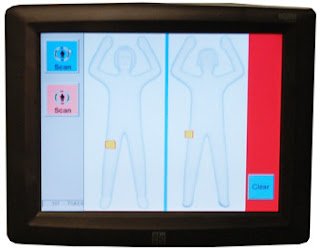The Transportation Security Administration is installing new software on its Advanced Imaging Technology (AIT) machines, also known as the body scanners, that is designed to improve individuals’ privacy by eliminating passenger specific images.
The new software, known as Automated Target Recognition (ATR) will auto-detect items that could pose a potential threat using a generic outline of a person for all passengers. In the coming months, TSA will install the software upgrade on all currently deployed millimeter wave imaging technology units at U.S. airports nationwide.
Since the image of the actual passenger will be removed, passengers will be able to see the images and a TSA officer will no longer be required to view the image in a remotely located screening room. TSA claims this will enhance privacy and efficiency of the screening process.
The software automatically detects potential threats and highlights them on the generic outline of the person. If a potential threat is detected, the area will require additional screening, such as an enhanced pat-down to check the suspected area for contraband.
The image the machines will display in such instances look like this:

Questions have been raised in the past about why additional screening would be needed for people with medical conditions or devices likely to set off a metal detector and why a doctor’s note, medical card or x-ray image would not suffice in these cases. The TSA answers those questions this way:
We understand that this is an inconvenience to travelers who repeatedly have to go through additional security measures because of a medical condition, but we just can’t accept a letter [from their doctor], a [medical] card or an x-ray.
This is a true story: a passenger told a security officer that he knew he was going to set the metal detector off because he had a pin in his hip. He hoped the officer would give him a pass on additional screening. Instead, the security officer followed TSA guidelines patted down the passenger. Guess what? He found a gun strapped to the passenger’s leg. So, if the security officer had just taken his word for it, a gun would have gotten on the plane—and maybe even been in the seat next to you. Things like this happen all the time, more than you would think.
“Our top priority is the safety of the traveling public, and TSA constantly strives to explore and implement new technologies that enhance security and strengthen privacy protections for the traveling public,” TSA Administrator John Pistole said. “This software upgrade enables us to continue providing a high level of security through advanced imaging technology screening, while improving the passenger experience at checkpoints.”
TSA worked with the Department of Homeland Security’s (DHS) Science & Technology Directorate (S&T) and private industry to develop the new software. In February 2011, TSA successfully tested the new software at Hartsfield-Jackson Atlanta International, Las Vegas McCarran International and Ronald Reagan Washington National airports.

